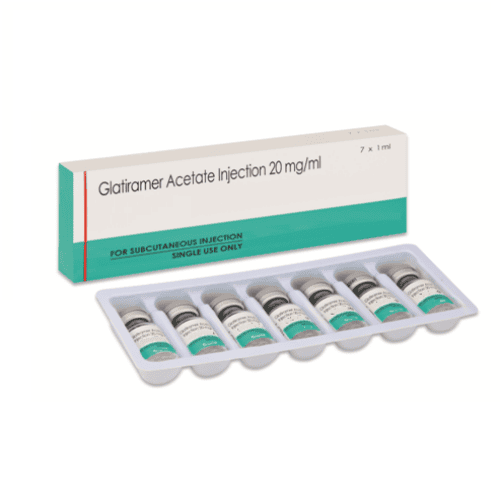This is an automatically translated article.
Glatiramer is an immunomodulatory drug that reduces the frequency of relapses of multiple sclerosis (MS) and prevents the risk of disability. Depending on the dose that the patient needs, Glatiramer will be injected once a day or 3 times a week, each time at least 48 hours apart.
1. What is Glatiramer? What does Glatiramer do?
Glatiramer is a protein that works by stopping the body's immune system from attacking nerves in the brain and spinal cord. Currently, Glatiramer is commonly prescribed to treat multiple sclerosis (MS).
Mechanism of action Glatiramer may reduce the number of relapses and prevent (or delay) the risk of disability in people with multiple sclerosis. However, due to its nature as an immunomodulator, Glatiramer cannot completely cure multiple sclerosis.
2. How to take Glatiramer
Glatiramer comes in 2 different dosage forms, which are given by injection under the skin as directed by your doctor. Depending on the dose that the patient needs, Glatiramer will be injected once daily or 3 times a week, spaced at least 48 hours apart. You need to strictly follow your doctor's instructions about how often to use Glatiramer. In particular, if you are taking Glatiramer at home, learn all the preparation steps, dosing instructions from your doctor, and the information on the product packaging. Usually with the first injection, your doctor will ask you to have it done in the clinic. Before injecting Glatiramer, you need to wash and dry your hands. Before use, the drug should be thawed at room temperature for 20 minutes (if the medicine is refrigerated). Glatiramer should not be given as a cold solution because it can cause pain. Glatiramer is usually clear, colorless or slightly yellow. Before use, observe this product with the naked eye for particles or signs of discoloration. If there is an abnormality, discard and do not use the solution. Before injecting each dose, it is necessary to disinfect the injection site with alcohol. It is important to change the injection site daily to avoid affecting the same area of skin. Monitor injection sites and do not re-inject the same site for at least 1 week. Inject Glatiramer under the skin of the hip, thigh, abdomen or back of the arm, not into a vein. After withdrawing the needle, gently press on the injection site but do not rub the area. The dose of Glatiramer will be prescribed based on your medical condition and response to treatment. Take Glatiramer regularly to get the most benefit from it. Do not change the dose or stop taking it on your own without talking to your doctor.

Thuốc Glatiramer có thể làm giảm số lần bệnh tái phát và ngăn ngừa nguy cơ tàn tật ở người bệnh đa xơ cứng
3. Undesirable effects
Like many other medicines, Glatiramer can also bring some side effects such as: Injection site reactions (such as pain, redness, soreness and swelling), nausea, chills, joint pain, neck pain and headache. Immediately after the injection, your body may experience flushing, chest pain, heart palpitations, anxiety, trouble breathing, or itching. These reactions usually occur in people who have been taking Glatiramer for several months or have not used it at all. If these symptoms do not go away within a few minutes, seek medical attention and also inform your doctor of this reaction before further injections. Ask your doctor whether you should continue taking this medicine. Tell your doctor if you have any serious Glatiramer side effects such as: Dizziness, fainting, chest pain, signs of liver disease (such as nausea, vomiting that won't stop, loss of appetite, stomach pain) , abdominal pain, yellow eyes, jaundice, dark urine, signs of infection (such as fever, persistent sore throat), mood changes (such as depression), severe pain at the injection site, tremors , swollen feet (due to water retention), vision problems.
4. Be careful when taking Glatiramer
Before taking Glatiramer, please note the following:
If you are allergic to the ingredients of the drug or have any other condition, please inform your doctor immediately; Talk to your doctor about your medical history, especially: Cardiovascular disease (such as chest pain, arrhythmia), liver disease. For pregnant women, Glatiramer should only be used when absolutely necessary. Discuss the benefits and risks of this medication with your doctor. It is not known whether Glatiramer passes into breast milk. If you are taking this medication for treatment, consult your doctor before breast-feeding. If you use an overdose of Glatiramer and you notice symptoms such as fainting or shortness of breath, you need to take the patient to the emergency room immediately. Do not share Glatiramer, needles and syringes with other people. If you miss a dose of Glatiramer, take it as soon as you remember. If it is almost time for your next injection, skip the missed dose and continue with your usual dosing schedule. Store the original Glatiramer syringe in the refrigerator, (do not freeze). Do not use frozen syringes. In cases where refrigeration is not possible, the drug can be stored at room temperature for 1 month. Do not expose the medicine to light or high temperatures, and keep it out of reach of children and pets.
Please dial HOTLINE for more information or register for an appointment HERE. Download MyVinmec app to make appointments faster and to manage your bookings easily.
Reference source: Webmd.com












